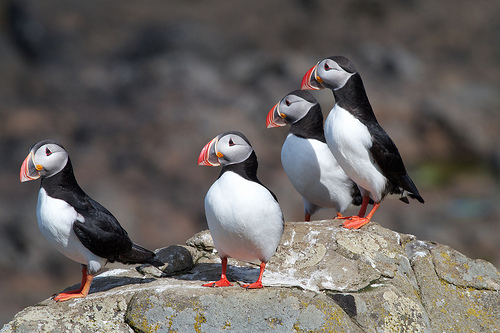Atlantic puffins are the parrots of the sea.
- Atlantic puffins are small flying birds that are native to the North Atlantic Ocean, and they are one of four species of puffins.
- ‘Atlantic puffins’ are also known as ‘common puffins’, ‘clowns of the sea’ and ‘sea parrots’, and the birds have an average lifespan of 15 to 30 years.
- The scientific name of an Atlantic puffin is Fratercula arctica, and it is from the family Alcidae, the family of auks, and even though some think that the bird is similar to a penguin, they are not related.
- Atlantic puffins typically grow to 25 to 30 centimetres (10 to 12 inches) in height; their weight generally ranges from 368 to 500 grams (13 to 18 ounces); and they have a 47 to 63 centimetre (18 – 25 inch) wingspan.
- The plumage colour of Atlantic puffins is typically coloured a combination of black, white and grey, while the bird’s large beak, legs and webbed feet are a vivid orange, although the beak generally turns grey in winter.
Atlantic Puffin
Image courtesy of Brain Gratwicke/Flickr
- The diet of Atlantic puffins consists primarily of fish, and also includes worms, molluscs, shrimp and crustaceans.
- Atlantic puffins catch their prey by diving underwater; they are excellent swimmers, although they are said to crash into the water when landing; and they are also good flyers and can reach up to speeds of 88 kilometres per hour (55 miles per hour).
- By bobbing for days on end, Atlantic puffins are able to survive on the surfaces of the ocean with no land in sight, and they spend a significant portion of the year on water, and return to land for breeding purposes.
- Female Atlantic puffins lay a single white egg annually in a burrow that is cared for by both parents, while hatching can take up to 45 days; and adults usually have only one partner during their life.
- Despite being listed as least concern, Atlantic puffin numbers have decreased over the past century and are threatened by pollution, especially oil spills; animals introduced to breeding grounds; and humans hunting for food.
Bibliography
Atlantic Puffin, 2015, National Geographic, http://animals.nationalgeographic.com.au/animals/birds/atlantic-puffin/
Atlantic Puffin, 2015, Wikipedia, http://en.wikipedia.org/wiki/Atlantic_puffin
Puffin, 2013, A-Z Animals, http://a-z-animals.com/animals/puffin/







